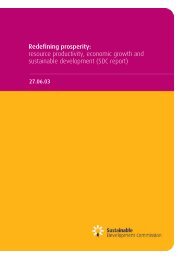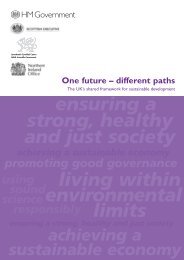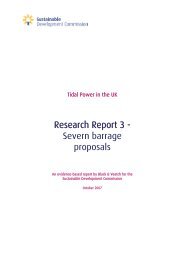Every Child's Future Matters - Sustainable Development Commission
Every Child's Future Matters - Sustainable Development Commission
Every Child's Future Matters - Sustainable Development Commission
You also want an ePaper? Increase the reach of your titles
YUMPU automatically turns print PDFs into web optimized ePapers that Google loves.
Priority 2: Green space<br />
A distressing conclusion of this paper is that<br />
children’s emotional health is suffering as a<br />
consequence of lack of access to (and experience of)<br />
green space, broadly defined to include well caredfor<br />
parks and outdoor recreational facilities as well<br />
as more natural habitats and spaces. Over the last<br />
fifty years children’s proximity to natural areas has<br />
reduced greatly as a result of industrial, road and<br />
housing developments in urban and rural places.<br />
Constant development on green rather brownfield<br />
sites continues to destroy areas of value to children<br />
for learning, discovery and play – including areas<br />
that are not managed for this purpose but are<br />
nonetheless used by children. This, combined with<br />
increasingly sedentary recreational pursuits (which<br />
may be encouraged by diminishing opportunities<br />
for outdoor play) reduce the time available for<br />
children to experience and connect with the natural<br />
world. This is bad for their physical and emotional<br />
health – and the health of their communities – and<br />
affects their ability to form lasting attachments<br />
with the environment and hence care for it during<br />
their lifetimes. English Nature’s Urban Green Space<br />
Standard recommends that everyone should have<br />
some natural green space within at least 300 metres<br />
of their home. This is a minimum recommendation:<br />
300 metres may feel like a long journey to a<br />
small child and any major road or risky feature of<br />
the journey is likely to be a significant deterrent –<br />
“it might as well be a river!”. 129<br />
Response 2a<br />
Those involved in planning and regenerating<br />
residential areas should make pedestrian access to<br />
(and management of) quality green spaces a high<br />
priority. They should take care to include natural<br />
habitats within their schemes as these have the<br />
greatest potential to promote emotional health and<br />
act as a resource for discovery and learning. Even<br />
minimal supervision by park or community wardens<br />
will help to ensure these spaces feel safe and remain<br />
of good quality.<br />
Example<br />
Northamptonshire County<br />
Council received Beacon status<br />
in 2002 for ‘Improving Green<br />
Urban Green Spaces.’<br />
Its Pocket Parks Programme, in<br />
partnership with organisations<br />
and other local authorities,<br />
has created 80 spaces owned<br />
and managed by local people.<br />
Spaces such as old brickyards<br />
and former landfill sites are<br />
transformed into biodiverse<br />
green spaces, some as small<br />
as 0.4 hectares.<br />
Ruth Douglas<br />
<strong>Every</strong> Child’s <strong>Future</strong> <strong>Matters</strong> 41








